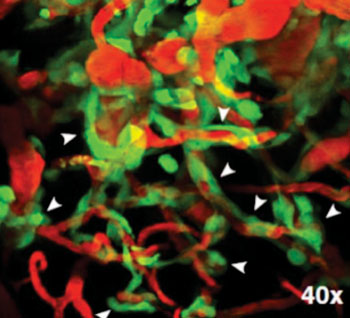Brain Tumors Grow by Tapping Preexisting Blood Vessels for Nutrients
By LabMedica International staff writers
Posted on 25 Aug 2014
Findings from a new study on how tumors grow and spread in the brain may cause cancer researchers to rethink treatment options based on drugs that block angiogenesis.Posted on 25 Aug 2014
According to the angiogenesis theory, tumors that are more than one cubic millimeter in size need to attract or grow their own blood vessels to survive. This theory led to clinical trials with anti-angiogenesis drugs such as bevacizumab and DC101. However, such clinical trials have failed to produce evidence of reduced tumor growth or increased patient survival.

Image: Microscopic view of a section of mouse brain shows tiny clusters of tumor cells growing along existing brain blood vessels (Photo courtesy of the University of Michigan).
Investigators at the University of Michigan (Ann Arbor, USA) examined this phenomenon in rodents and human cancer patients and by advanced computer modeling.
They reported in the July 2014 issue of the journal Neoplasia that implanted rodent and human brain cancer cells commonly invaded and proliferated within the brain perivascular space. This form of brain tumor growth and invasion was also shown to characterize de novo generated endogenous mouse brain tumors, biopsies of primary human glioblastoma, and peripheral cancer metastasis to the human brain.
Perivascularly invading brain tumors became vascularized by normal brain microvessels when individual glioma cells used perivascular space as a conduit for tumor invasion. Since the cancer cells were obtaining blood from already existing vascular tissues, their growth and spread were not impeded by treatment with antiangiogenic agents.
The experimental findings showing that tumor perivascular spreading was independent of growth of new blood vessels had been predicted by computational modeling. The investigators tested this prediction experimentally by blocking angiogenic signaling using antibodies targeting the VEGF-A (vascular endothelial growth factor) signaling axis. VEGF-A inhibitors failed to block progressive tumor growth or extend median survival in multiple brain tumor models.
"The key question has been to determine how tumor-generating cells grow to form the macroscopic tumor mass that eventually kills the patients," said senior author Dr. Pedro Lowenstein, professor of neurosurgery and cell and developmental biology at the University of Michigan. "We have shown that because of the very high density of endogenous vessels in the brain and central nervous system, the cells grow along those preexisting vessels and eventually divide to fill the space between them, where the distance between any two vessels is very small. This iterative growth along vessels and into the space between means the tumor does not grow like a balloon requiring new vessels to grow into its expanding mass to rescue it, but rather as an accumulation of local small masses which then coalesce into a large tumor."
Related Links:
University of Michigan













